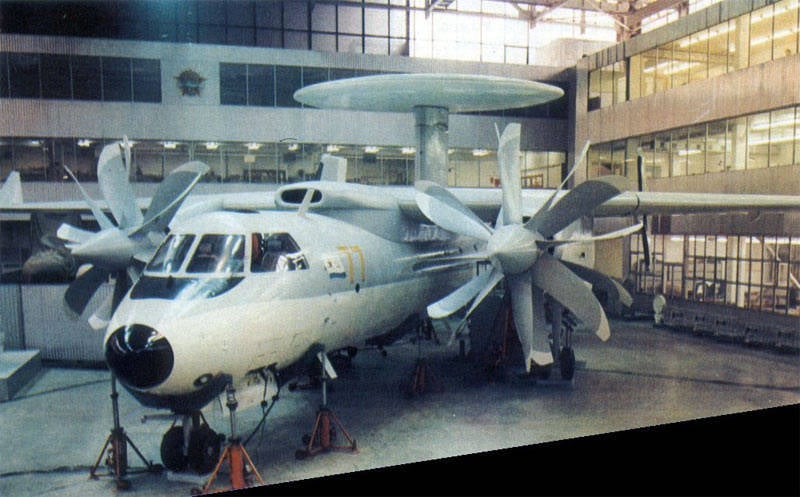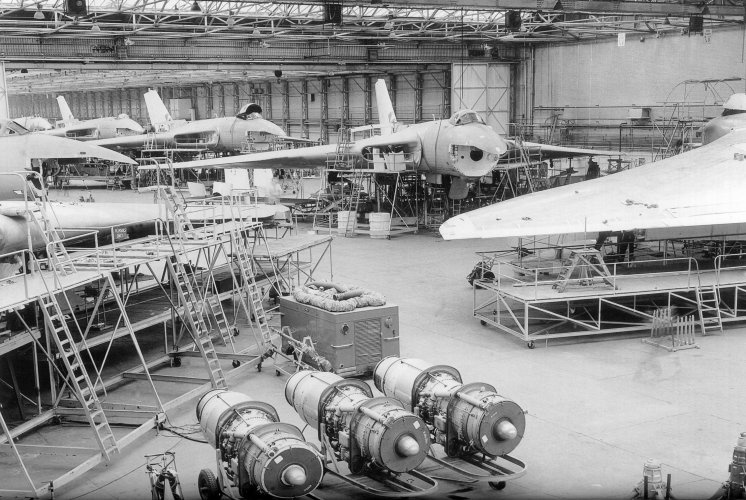Project Seascan
-

Project Seascan was the response of aerospace and defence giant, RAe Systems, to the government and armed force's Carrier-borne AWACS procurement program in the 1980s. This project led to the development of the currently used Mireuk AEW.3 Carrier-borne AWACS, named after the Korean creator god Mireuk, similar to the Duxburian E-2. Since its development, it has also been used as COD for some time by the Royal Navy and was also exported to various countries. Today, the Mireuk only serves as a Carrier-borne AWACS after the Merlin HC.5 replaced it from service as COD.
OOC
This thread is reserved to RP the aircraft's development in the 1980s in line with the war system requirements as its RL Basis, the Yak-44, only made it to a few ground tests and a mockup carrier test. No flying prototype of the aircraft was made and therefore this shall serve as what could've been the continuation of the developments.
-
Road to the First Flight

Design tests on the Mireuk had already been done and a prototype was underway. 3 prototypes are already being assembled at the factory with their avionics ready to be fitted in anticiption for a few ground tests and eventually the flight test. At the factory, workers are carefully bringing together the parts, from the engines to the landing gear and the wings. Eventually, they get to finish the primary airframe and installed the radome on top. The mechanisms were tested and verified for some time before being certified ready for flight. A few days pass, and the first prototype was finished and unveiled to the public. And the next day, it had to fly.

First Flight
Engineers brought the aircraft to the runway for its first flight. In the aircraft, there were two test pilots, Peter Nicholson and Nick Eades of the Royal Navy Fleet Air Arm. The first flight was very normal, yet everyone kept their eyes fixed on the aircraft's behavior in flight. It was short, 10 minutes to be exact, but enough to prove the aircraft performs nicely without problems. After the craft landed, it taxied immediately to the hangar for inspection and assessment. Engineers found no problem on the external structure and the prototype appears fine. Within the next two days, engineers further assessed the aircraft for more detailed problems. One of which came on the control surfaces, specifically the left wing aileron, which was stiffer and slightly not in sync with the right wing aileron. Some changes were applied to remedy what happened.Run-around Flight Tests
After the first flight, four subsequent run-around flight tests were made. Each flight test got longer and longer with the craft travelling farther and farther. It was necessary to test the craft's endurance and its avionics at longer flights. Throughout the series of tests, some minor modifications were made such as flight computer coding, addition of more avionics, weight test of the on-board radar system, and full loading test for the COD variant. Three more passengers who will act as the radar operators join the third and fourth flight in the series, it was done to test the weight loading of the prototype and simulate the stability of the aircraft when fully loaded. Once all the necessary adjustments and calibrations were made to the aircraft stability and avionics, the craft was ready to try flying from one airfield to another.Full Flight Tests
The first full flight took place throughout the next months after the run-around tests. The plane went from Manchester Aircraft Assessment Facility to Salisbury Global Airport and vice versa on a short flightpath. Once the craft first landed on Salisbury Global Airport, engineers waiting for the plane examined the prototype on a small hangar temporarily rented from Asiana Airlines. Not much problems are detected and the craft went on to fly back to Manchester Aircraft Assessment Facility where engineers are also waiting to further examine the effects of the forces acting on the aircraft. Upon examination, there seems no problem encountered. On the next 3 flight tests, the prototype travelled farther and farther to see its range without in-flight refueling, a feature system that is still to be tested and verified safe to conduct. The farthest the aircraft went throughout the test without refueling (both ground and in-flight) are from Manchester Aircraft Assessment Facility to Cair Para and vice versa, within the country it was determined that the craft had a range greater than the distance of the farthest airport from the Manchester facility. This led to engineers capping the craft's range at 4000km. The next 5 flight tests after the range test covered the craft's landing and take-off distance at various levels of loaded weight. At maximum load, the engineers determined the craft could take-off at a 700m runway with 200m clearance and land at the same length runway with 300m clearance. The statistics for the landig and take-off speeds satisfy the requirements the engineers see necessary to proceed with having the aircraft operate on carriers at sea. After the distance test, the next 3 tests dealt with speed and service ceiling. The next tests involved some minor modifications to the airframe and improvements to the engine to meet the requirements. These modifications and improvements led to a max speed of approx. 740 km/h with a service ceiling of about 13km above sea level. To end the part of the flight tests, 3 final tests that deal with the aircraft's radar cross section, avionics performance, and operational range were conducted. The craft flew from Manchester Aircraft Assessment Facility to Salisbury Global Airport while passing through a field with various radars in different frequencies, this was done to fetch the data on the craft's RCS while in-flight. When the craft went for the return flight, the avionics and the radar's performance at communication and detection of targets were assessed. Some target drones of various sizes to simulate various radar cross sections were flown to test the onboard radar systems' capability to detect low rcs and low profile aircraft. In addition, two fighter jets flew near to simulate data sharing and test the range to which the datalink system works. With all these tests done, this part of the flight testing ended successfully.Pre-Carrier Trials
Before testing the prototype on-board a carrier, it was necessary to assess it and test the craft's behavior at simulated carrier environments. This included take-off testing on a ground-based catapult and ski-jump systems, and landing on a ground-based arresting wire and barrier systems. Ten test flights involving these systems were conducted, each deals with identifying the range, service ceiling, loading limit, landing gear stress, and capability to take-off and land. Some adjustments to the internal structure and configuration of the avionics and load inside were made to compromise the problems encountered. Apart from this, the craft was also tested on both normal and carrier-style runways to conduct in-flight refueling and countermeasure dumping. The in-flight refueling system was modified and both probe-and-drogue and flying boom being assessed on the more efficient system to be implemented, in the end the engineers selected the probe-and-drogue for less complexity. Despite this, engineers also settled to test and finalize a flying boom adapter-installed variant in the future. Eventually, this flying boom adapter variant is developed 20 years after the craft first entered service. Aside from modifications to the ifr-system, the landing gear also went through various changes to make it safer and sturdier when landing on a carrier at very high speed. After all the tests, the craft was about ready to proceed to the actual carrier trials.
